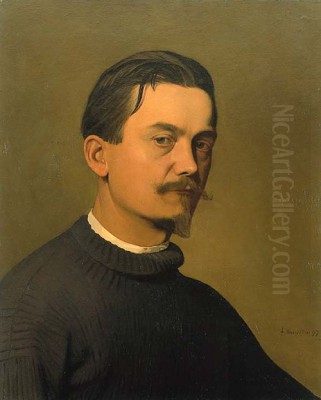
Félix Edouard Vallotton stands as a unique and pivotal figure in the transition from 19th-century realism to the complexities of modern art. A Swiss-born artist who later adopted French nationality, Vallotton navigated the vibrant Parisian art scene at the turn of the century, leaving an indelible mark as both a painter and, perhaps even more significantly, a master printmaker. His association with the Nabis group connected him to the avant-garde, yet his distinctively cool, often unsettling style set him apart, creating a body of work known for its sharp observation, technical brilliance, and psychological depth.
Early Life and Artistic Formation
Born in Lausanne, Switzerland, on December 28, 1865, Félix Vallotton grew up in a relatively conservative bourgeois family. His early aptitude for art led him to formal studies, first briefly in Lausanne before he made the crucial move to Paris in 1882, at the age of seventeen. Paris was the undisputed center of the art world, and Vallotton enrolled at the prestigious Académie Julian, a private art school known for attracting international students and offering an alternative to the rigid official École des Beaux-Arts.
At the Académie Julian, he studied under traditional academic painters like Jules Joseph Lefebvre and Gustave Boulanger. During these formative years, Vallotton dedicated himself to mastering draftsmanship and traditional techniques. He spent countless hours at the Louvre, meticulously copying the works of Old Masters he deeply admired, particularly Hans Holbein the Younger, Albrecht Dürer, and Jean-Auguste-Dominique Ingres. This reverence for linear precision and clarity of form would remain a subtle underpinning throughout his career, even as he embraced modern aesthetics.
His early paintings reflect this academic training and admiration for realism. Works from the late 1880s often feature portraits and genre scenes rendered with meticulous detail and a cool, objective finish. A notable example is his striking Self-Portrait of 1885, which showcases his technical skill and a serious, introspective demeanor. These early pieces demonstrated his command of traditional painting but also hinted at a certain emotional detachment that would become a hallmark of his mature style.
The Nabis and the Allure of the Avant-Garde
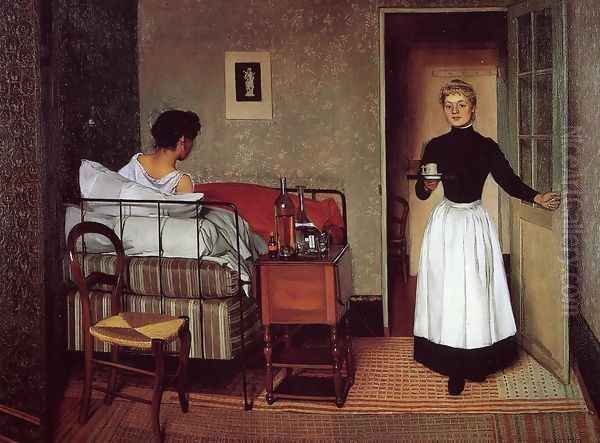
The 1890s marked a significant turning point in Vallotton's career. He came into contact with Les Nabis (Hebrew for "prophets"), a dynamic group of young Post-Impressionist artists who sought to revitalize painting by breaking away from naturalism. Key members included Pierre Bonnard, Édouard Vuillard, Maurice Denis, Paul Sérusier, and Ker-Xavier Roussel. Drawn together by a shared admiration for Paul Gauguin's synthetism and symbolism, the Nabis emphasized flat planes of color, decorative patterns, and subjective expression.
Vallotton formally associated with the Nabis around 1892. Although Swiss, he became known within the circle as "le Nabi étranger" (the foreign Nabi). He shared their interest in exploring new artistic avenues, including graphic arts and the integration of art into everyday life. He contributed illustrations to avant-garde publications like La Revue Blanche, a crucial journal that championed the Nabis and Symbolist writers. His interactions with Bonnard and Vuillard, in particular, were marked by lifelong friendship and mutual respect, though his artistic temperament remained distinct.
While embracing certain Nabis principles, such as simplified forms and flattened perspectives, Vallotton maintained a harder edge and a more critical, less purely decorative or intimate approach than many of his Nabis colleagues. His color palette could be bold but often employed stark contrasts, and his compositions retained a sense of rigorous structure, likely stemming from his earlier classical training and his burgeoning interest in Japanese prints.
Revolutionizing the Woodcut
It was during his Nabis period that Vallotton made arguably his most revolutionary contribution: the revival and reinvention of the woodcut as a modern art form. Inspired profoundly by Japanese ukiyo-e prints, particularly the works of masters like Hokusai and Hiroshige, Vallotton recognized the expressive potential of this often-neglected medium. He was captivated by the Japanese artists' bold compositions, flat areas of color, asymmetrical designs, and elegant simplification of form.
Beginning in 1891, Vallotton produced over two hundred woodcuts that stunned the Parisian art world. He eschewed the traditional, detailed tonal modeling of European wood engraving, instead embracing large, stark masses of black and white, sharp, decisive outlines, and radically simplified forms. This technique lent itself perfectly to capturing the essence of a scene or figure with graphic immediacy and power. His woodcuts often depicted scenes of Parisian life – crowds, street incidents, political events, and domestic interiors.
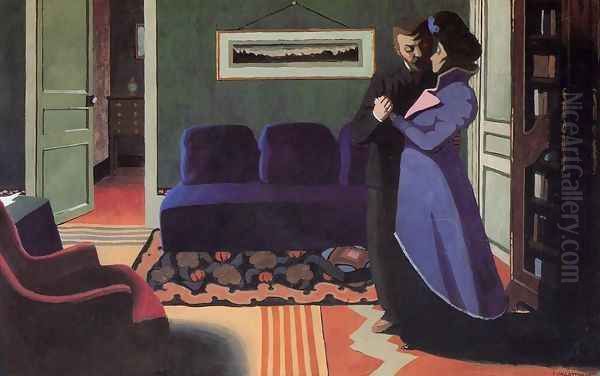
His most celebrated series of woodcuts is Intimités (Intimacies), created between 1897 and 1898. This set of ten prints delves into the tense, often hypocritical relationships between men and women in bourgeois interiors. With titles like Money, The Lie, and The Triumph, the series uses dramatic lighting contrasts and claustrophobic settings to expose hidden emotions and power dynamics. The figures are often reduced to near silhouettes, their gestures and proximity conveying complex psychological narratives with remarkable economy. These works cemented Vallotton's reputation as a master printmaker and influenced artists across Europe, including Edvard Munch and the German Expressionists like Ernst Ludwig Kirchner.
Painting: Observation, Irony, and Detachment
While his woodcuts brought him international acclaim, Vallotton continued to paint throughout his career, developing a style that was uniquely his own. His paintings often share the characteristics of his prints: clarity of line, flattened space, unusual cropping influenced by photography and Japanese art, and a certain emotional coolness or distance. He tackled a wide range of subjects, including portraits, landscapes, still lifes, and, most controversially, nudes.
His Nabis-era paintings, such as Bathers on a Summer Evening (1892-93), show the influence of the group's decorative tendencies but with a characteristic twist of irony and awkwardness in the figures' poses. The painting depicts stylized female figures in a landscape, but the scene feels less idyllic and more staged, hinting at underlying tensions. Similarly, The Balloon (1899) presents a park scene from a high, detached viewpoint, reducing figures to small shapes dominated by large, flat areas of color representing paths and grass – a radical departure from Impressionist landscapes.
Vallotton's interior scenes often carry the same psychological weight as his Intimités woodcuts. He depicted bourgeois parlors and bedrooms with meticulous detail, but the smooth surfaces and ordered compositions frequently mask simmering conflicts or unspoken desires. The figures within these spaces often seem isolated or engaged in ambiguous interactions, leaving the viewer to decipher the narrative. This sense of unease and critical observation of social mores became a defining feature of his work.
The Unconventional Nude
Vallotton's treatment of the female nude was particularly distinctive and often challenging for contemporary audiences. Unlike the idealized nudes of academic tradition or the sensual nudes of artists like Renoir, Vallotton's nudes are often presented with a stark objectivity, sometimes bordering on the clinical or awkward. He rendered flesh with smooth, clear contours, but the poses could be unconventional, and the figures often lack traditional markers of beauty or allure.
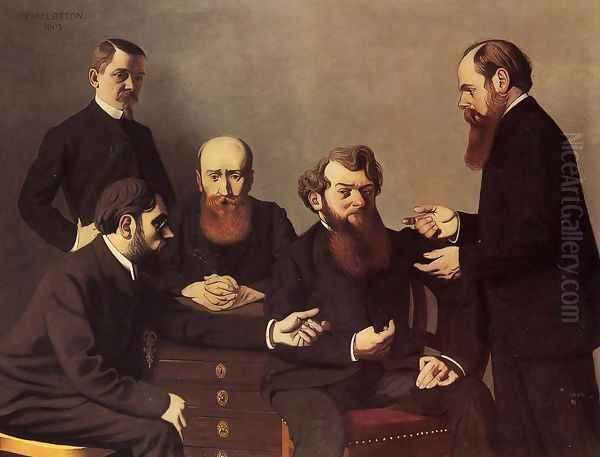
Works like The White and the Black (1913), depicting a white woman reclining near a Black woman servant, play with art historical tropes while introducing a modern sense of detachment and potentially unsettling social commentary. His nudes rarely seem passive objects of desire; instead, they possess a strong physical presence and often an inscrutable psychological state. This cool, sometimes described as "icy," eroticism set his nudes apart and contributed to his reputation as an artist who confronted uncomfortable truths. His portraiture also displayed this penetrating gaze, capturing subjects like the writer Gertrude Stein (1907) with an unflinching directness.
Landscapes and Later Work
Vallotton was also a dedicated landscape painter throughout his life. His landscapes often feature simplified forms, broad areas of unified color, and dramatic light effects. He frequently depicted views of Normandy, Brittany, and the French countryside near Honfleur, where he often spent time. Even in his landscapes, a sense of order and structure prevails. He was less interested in capturing fleeting atmospheric effects, like Claude Monet, and more focused on the underlying geometry and emotional resonance of the scene. Some later landscapes achieve a near-abstract quality through their radical simplification and bold color choices.
After 1900, Vallotton gradually distanced himself from the Nabis group aesthetic, returning to a more objective, though still modern, style of painting. His technique remained precise, but his compositions sometimes became more complex. The outbreak of World War I deeply affected him. Although too old for military service, he sought permission to visit the front lines in 1917. This experience resulted in a series of powerful war paintings, including the stark and symbolic Verdun (1917), which uses geometric forms and dramatic color to convey the devastation and chaos of the battlefield, moving towards a form of abstraction.
Literary Pursuits and Personal Life
Beyond his visual art, Vallotton possessed literary talents. He wrote art criticism, plays, and several novels. His most notable novel, La Vie meurtrière (The Murderous Life), published posthumously in 1930 though written much earlier (around 1907), is a dark, psychologically intense story about an artist struggling with societal constraints and inner turmoil. This foray into literature underscores the intellectual depth and critical perspective that informed his visual work.
In 1899, Vallotton married Gabrielle Rodrigues-Henriques, a wealthy young widow from a prominent family of art dealers (Bernheim-Jeune). This marriage brought him financial security but also perhaps distanced him somewhat from the more bohemian circles of his earlier Nabis days. Despite this change in circumstance, his art continued to exhibit its characteristic sharpness and critical edge. He obtained French citizenship in 1900. Vallotton passed away in Paris on December 29, 1925, one day after his sixtieth birthday, following cancer surgery.
Legacy and Influence
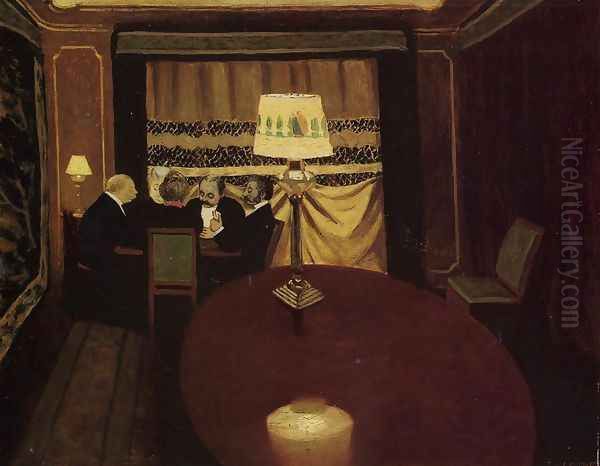
Félix Vallotton occupies a unique space in art history. He was a key participant in the Nabis movement, absorbing and contributing to its Post-Impressionist innovations. However, his individualistic style—characterized by its cool precision, linear clarity, psychological tension, and often ironic detachment—distinguishes him from contemporaries like Bonnard or Vuillard. His profound engagement with the woodcut medium single-handedly revitalized it as a powerful tool for modern artistic expression, directly influencing the graphic work of the German Expressionists and others.
His paintings, with their unsettling blend of realism and stylization, sharp social observation, and exploration of complex human relationships, continue to resonate. He masterfully bridged influences from the Northern Renaissance masters like Holbein, the linear grace of Ingres, the modern subject matter of Edgar Degas and Édouard Manet, the decorative flatness of Gauguin and the Nabis, and the graphic power of Japanese prints.
Vallotton's legacy lies in his uncompromising vision and technical mastery across both painting and printmaking. He was an artist who looked unflinchingly at the surface of modern life and hinted at the anxieties and complexities lurking beneath its polished veneer. His work remains compelling for its formal innovation, its psychological acuity, and its enduringly modern sensibility. He remains a crucial figure for understanding the diverse paths artists took at the turn of the twentieth century, forging a unique visual language that continues to intrigue and provoke.